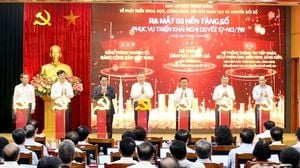The countdown to the 2025 Bundestagswahl is officially on, and just three weeks out from the polls, citizens are gearing up to make informed choices. At the forefront of tools aiding voters is the Wahl-O-Mat, which has recently been made available by the Bundeszentrale für politische Bildung (bpb). This online platform allows users to gauge which political parties best align with their own viewpoints by answering 38 key theses.
Historically, the Wahl-O-Mat has become instrumental for millions of voters. Since its inception during the 2002 Bundestagswahl, it has accumulated 130 million uses, with the last election alone reaching record numbers—21.3 million uses. The tool serves not merely as entertainment; it positions itself as a serious educational measure, empowering voters by allowing them to compare their responses to those of the parties vying for electoral success. This year, the stakes are high, particularly with recent polling indicating the Union at 28 percent, followed by the AfD at 20 percent, dabbling with the edges of traditional party politics amid frenzied competition.
The development process for this year’s Wahl-O-Mat faced unusual time constraints due to the expedited schedule of the early elections. President of the bpb, Thomas Krüger, reaffirmed to journalists how the organization worked diligently to uphold its quality standards. Typically, the apparatus requires nearly three-quarters of a year for preparation; this time, it took only weeks, underscoring the commitment to produce comprehensive, accessible political education tools.
Integral to the Wahl-O-Mat’s formulation is the unique methodology by which the theses are developed. A youth editorial team, comprised of young voters from diverse backgrounds—who applied to participate—was chosen to collaborate with experts from academic fields. A comprehensive workshop facilitated the assembly of 80 theses grounded in the manifestos of all eligible parties contesting for seats. Only 38 theses were eventually selected based on their capacity to address controversial topics and resonate broadly among the electorate.
While examining its parameters, selections made by the parties themselves are particularly noteworthy. They were invited by the bpb to participate and provide their answers independently. Each party had two weeks to formulate their responses to the theses, denoting positions of 'agree,' 'disagree,' or 'neutral' and offering justification for their stance. It's important to note the distinction: Theses requiring consensus among the masses were prioritized, with debates around party positions freely accessible for voter scrutiny.
Even political parties labeled as extremist by the Federal Office for the Protection of the Constitution were invited to participate, reflecting the liberal stance of the tool. The bpb guarantees the impartial nature of the Wahl-O-Mat by not only overseeing it but also by ensuring all user and party data remains confidential. Citizens can compare personal positions with those of the parties without the concern of their data being tracked or stored.
Voter education is underscored by the fact the Wahl-O-Mat itself does not serve as a recommendation for any single party—it merely offers insights meant to stimulate independent political discourse and decision-making. It compels users to engage with the substantive differences and similarities between party policies beyond superficial alignment.
For many young voters, this has become particularly pertinent as politics continues to evolve rapidly. The participation of numerous younger individuals—24 young voters from various regions—demonstrates the hope of establishing connections between youth and political instances more effectively. This is important for enhancing democratic awareness within society.
The proximity of the election is also spurring rich conversations among citizens. Upcoming days will witness the first Quadrell of the TV history, where key candidates from the leading parties will participate, forging pathways for citizens to connect more deeply with their options. What this traditional political dialogue lacked for many citizens has now been bridged by tools like the Wahl-O-Mat and developmental phases such as workshops helping to construct relevant and engaging content.
With Germany's political future hanging by the threads of these engagements, both the debates and the zuvor ảnh hs sit poised to inform and shape the electorate.
Indeed, election cycles are not just about numbers—they reflect the values, beliefs, and the pressing needs of the society they represent. The Wahl-O-Mat's impact resonates beyond the personal. It encompasses the collective view and operations of the electorate, promoting civic engagement through knowledge and informed dialogue.



